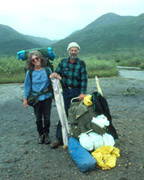Skunk Cabbage Is A Stinky Spring Harbinger
©Bert Gildart: Along the country road where we sometimes live when not traveling in our Airstream (we’re not full timers, only 9/12-ers), in places there’s the persistent but faint odor of skunk. But the source is not animal, rather it is vegetable.
We see the plant every year in late April and in this part of the country we see it in wooded areas where water tends to collect. Such areas may be small, but they are always swampy, not it might seem, particularly inviting for the creation of colorful plants. But look again.

Now rearing its head from swampy wooded areas along Montana's Flathead River, Skunk Cabbage is a stinky spring harbinger.
Rearing from the pools of dark water are foot-high rows of a plant having light green leaves and now producing a brilliant yellow blossom.
Appropriately, the species is known as skunk cabbage, and it truly is one of nature’s more interesting plants. Its presence (along with balsam root and grouse) also means that spring has arrived. For reasons that should be apparent by looking at the images posted here, the plant is also known as “Swamp Lantern.”
INDIGENOUS USES
In days of old the plant was used by indigenous people as medicine for burns and injuries, and for food in times of famine, when almost all parts were eaten.
The leaves, according to one writer who apparently was in the know, have a somewhat spicy or peppery taste.
Some of the taste might result from the presence of the calcium oxalate crystals contained in the leaves, a substance that produces “a gruesome prickling sensation on the tongue and throat.”
In various forms the plant is found throughout the north and if you stumble across it you will note its large, waxy leaves, which were also important to Native Americans in the preparation of food and in its storage.
Leaves were used to line berry baskets and several writers say they were used to wrap around whole salmon and other foods before placing them under a fire for baking.
The plant is also eaten by bears, who eat it after hibernating. Apparently it works for them as a laxative.
PHOTO TECHNIQUES
Yesterday, when I photographed the plant, I accessed the swampy area after a two mile ride north on my bike. In addition to appropriate camera equipment, I also carried a tarp for lying on the wet spongy ground.
The day was overcast and provided the ideal condition for preserving detail in areas often blocked up on sunny days. For depth of field, I used a long time exposure and a small aperture, probably f-22.
In this part of the country skunk cabbage is always one of the first plants to bloom, meaning that it is also one of the harbingers of spring, albeit a stinky one!
——————————————————
THIS TIME TWO YEARS AGO:
ADS FROM GOOGLE AND AMAZON AUGMENT OUR TRAVELS


